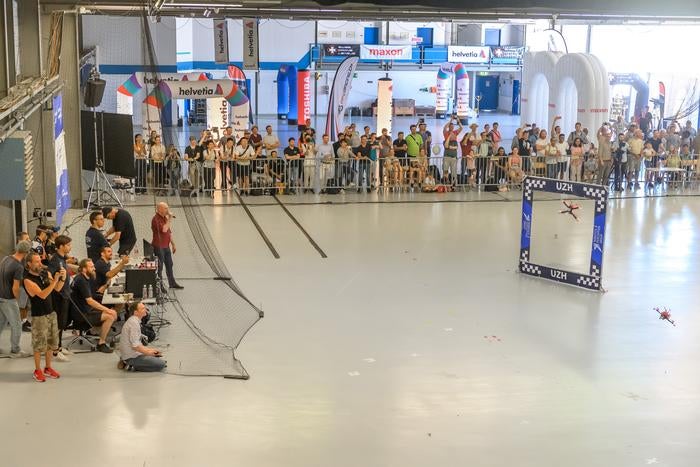AI defeats human drone-racing champions in historic world first
Physical sports are more challenging for AI since they are less predictable
An artificial intelligence system has achieved a key milestone by winning multiple races against three world-class drone-racing champions, marking the first time AI has beat humans at a physical sport.
The AI system called Swift, developed by researchers from the University of Zurich in Germany and Intel, could prove its mettle in first-person view (FPV) drone racing – a sport in which pilots fly quadcopters at speeds exceeding 100kmph.
Until now AI systems have achieved a number of remarkable victories over humans in a range of strategy-based games, including IBM’s Deep Blue winning at chess against Gary Kasparov in 1996 and Google’s AlphaGo defeating top Go champion Lee Sedol in 2016.
However, physical sports are more challenging for AI as they are less predictable than board or video games.
“We don’t have a perfect knowledge of the drone and environment models, so the AI needs to learn them by interacting with the physical world,” Davide Scaramuzza, one of the authors of the study from the University of Zurich, explained.
AI-driven autonomous drones have until now taken twice as long as those piloted by humans to fly through racetracks unless an external position-tracking system was used to precisely control their trajectories.
But the new Swift AI drone, described in a new study in the journal Nature, has demonstrated that it can react in real-time to the data collected by an onboard camera, just like the one used by human racers in the sport.
Sensors on the drone measure acceleration and speed while the AI system uses data from the camera to locate the drone in space and detect the gates along the racetrack.
A control unit in the drone, also based on AI, a control unit, then chooses the best action to finish the race circuit as fast as possible.
Researchers say the Swift drone trained itself to fly in a simulated environment by trial and error.
Using simulations, scientists could avoid destroying multiple drones in the early stages of learning when the system often crashes.
“To make sure that the consequences of actions in the simulator were as close as possible to the ones in the real world, we designed a method to optimise the simulator with real data,” study first author Elia Kaufmann said.
During the testing phase, the drone flew autonomously using very precise positions provided by an external position-tracking system, while also recording data from its camera.
By comparing the two data sets, Swift could learn to autocorrect errors it made in interpreting information from the onboard sensors, scientists say.
The AI was soon ready to challenge some of the world’s top human drone pilots – the 2019 Drone Racing League champion Alex Vanover, the 2019 MultiGP Drone Racing champion Thomas Bitmatta, and three-time Swiss champion Marvin Schaepper.

In races that took place between 5 and 13 June 2022, on a special track designed in a hangar of the Dübendorf Airport near Zurich, Swift achieved the fastest lap, with a half-second lead over the best lap by a human pilot.
The special track – about 25 by 25 meters in dimension – was built with seven square gates that had to be passed in the right order to complete a lap.
Drones had to execute challenging maneuvers to successfully finish the track, including an acrobatic “Split-S” feature that involves half-rolling the drone and executing a descending half-loop at full speed.
While Swift could record the fastest lap, humans are more adaptable than the AI drone, which failed when the conditions were different from what it was trained for, scientists say.
However, they add that the new breakthrough in AI flight is an important way beyond drone racing.
“Drones have a limited battery capacity; they need most of their energy just to stay airborne. Thus, by flying faster we increase their utility,” Dr Scaramuzza said.
The new research, according to scientists, may lead to better drones for forest monitoring or space exploration, and in cases where flying fast is important to cover large spaces in a limited time.
They say fast AI drones could also be used for shooting action scenes in movies and may also “make a huge difference” for rescue drones sent inside a burning building.
Join our commenting forum
Join thought-provoking conversations, follow other Independent readers and see their replies
Comments


Bookmark popover
Removed from bookmarks